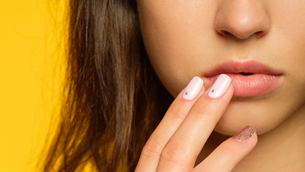
.png)
About Cold Sores & Fever Blisters.
Cold Sores or "Fever Blisters" are very common and usually appear as a group of small blisters usually on the lip and around the mouth. 90 percent of the population gets at least one cold sore in a lifetime, and 40 percent of American adults repeatedly get cold sores. Cold sores are uncomfortable and usually painful beginning as a blister as a blister and then forming a crust.
Cold Sores are caused by the herpes simplex virus (HSV). There are two types of HSV, type 1 (HSV-1) which usually causes cold sores and type 2 (HSV-2) which usually causes genital herpes but either type can create sores on either the mouth or genitals. There is no cure for HSV and usually remains in your body for your entire life but it is a manageable.
Although a cold sore infection is generally not serious, it can be a major issue for people with depressed immune systems due to disorders or medications. Even after a cold sore crusts over and heals, the herpes virus remains, and it can cause future outbreaks in the same area of the mouth or face.
There are several stages that a Cold Sore goes through. The first sign of a cold sore usually starts with what people describes as a "tingle". This is a sign that a fever blister is developing. Within the next 24 to 48 hours, a blister usually forms. Eventually, it breaks open and begins to ooze, and then it dries out and crusts over. A scab forms and protects the new skin that’s growing underneath. The virus is contagious until it dries out and scabs over.
scroll
A cold sore goes through five stages:
Stage one: Tingling and itching occurs about 24 hours before blisters erupt.
Stage two: Fluid-filled blisters appear.
Stage three: The blisters burst, ooze, and form painful sores.
Stage four: The sores dry out and scab over causing itching and cracking.
Stage five: The scab falls off and the cold sore heals.

Cold Sore Treatment
The most common conventional treatments for cold sores are antiviral creams and oral medications, which can reduce the duration of cold sores by a few days but aren’t completely reliable. There are natural cold sore remedies, however, that are safe, inexpensive and effective in boosting the immune system, relieving pain and swelling, and reducing the duration and frequency of cold sores.
Cold Sore Triggers
According to the Mayo Clinic, 90 percent of adults worldwide test positive for the herpes simplex type 1 virus. Once you have the virus, certain risk factors may reactivate it such as:
-
Infection, fever, or a cold
-
Sun exposure
-
Stress
-
HIV/AIDS or a weakened immune system
-
Hormonal Changes
-
Eczema
-
Chemotherapy
-
Dental work
You’re at risk of getting a cold sore if you come in contact with the fluid of a cold sore through kissing, sharing foods or drinks, or sharing personal care items such as toothbrushes and razors. If you come in contact with the saliva of someone who has the virus, you can get the virus, even if there are no visible blisters.
















